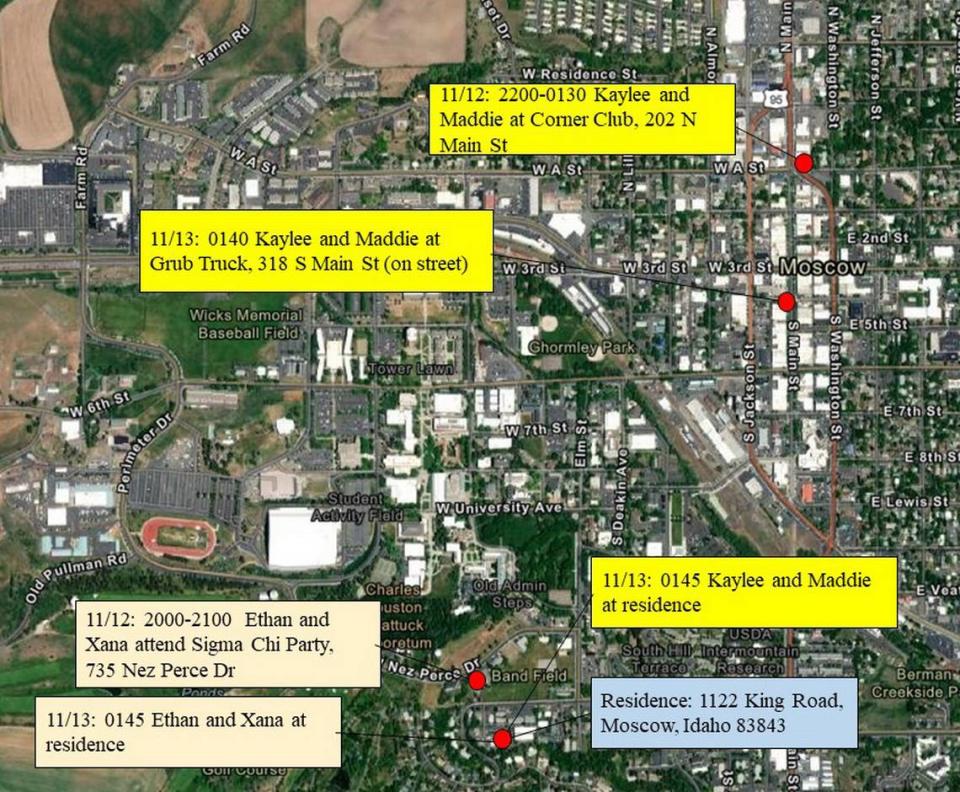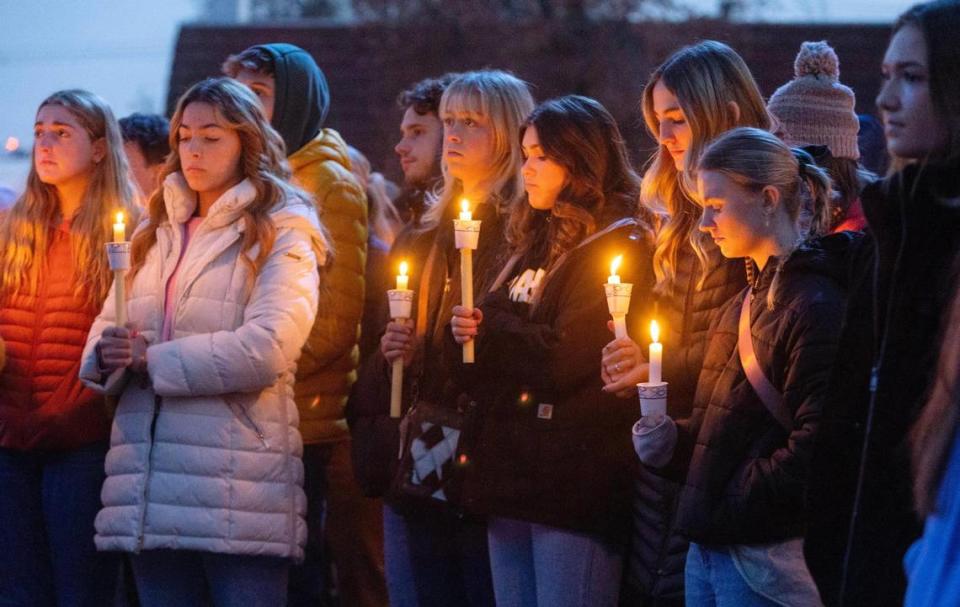What have we learned about the University of Idaho killings? Here’s everything we know
The University of Idaho held a candlelight vigil Wednesday for the four students found dead Nov. 13 in a house near campus. But almost three weeks after the students were found, the Moscow Police Department, Idaho State Police and FBI have not named a suspect.
Police have repeatedly said they are keeping many details confidential to maintain the integrity of the investigation, but are also yet to find the weapon used or a motivation for the homicides.
Most recently, Moscow police confirmed that a sixth person was on the lease for the rental home but had moved out before the semester and was not present when the killings occurred.
Here’s what we know about the investigation and what happened that weekend.
What happened on that weekend?
Shortly before noon Pacific time on Sunday, Nov. 13, Moscow police officers responded to a 911 call about an unconscious person in a house near the U of I campus. They walked in to find four dead bodies. Latah County Coroner Cathy Mabbutt reported that the students had been stabbed to death with a large, fixed-blade knife in the early morning hours.
The coroner’s report did not include times of death, but Moscow Mayor Art Bettge previously told the Idaho Statesman that the students were killed between 3 a.m. and 4 a.m. that Sunday.
Autopsies confirmed that all four died from multiple stab wounds and that all were likely asleep when the attacks started. Some victims showed defensive wounds. None of the victims showed signs of sexual assault, the coroner said.
Steve Goncalves, father of victim Kaylee Goncalves, revealed at a memorial vigil Wednesday that his daughter and Madison Mogen died together. The two victims had been close friends since sixth grade.
“They went to high school together,” Steve Goncalves said in a speech at U of I. “Then they started looking at colleges. They came here together. They eventually get into the same apartment together. And in the end, they died together, in the same room, in the same bed.”
Who were the victims?
The four were U of I seniors Madison Mogen, 21, of Coeur d’Alene, and Kaylee Goncalves, 21, of Rathdrum; junior Xana Kernodle, 20, of Post Falls; and freshman Ethan Chapin, 20, of Mount Vernon, Washington.
The three women, Kernodle, Mogen and Goncalves, lived at the King Road home with at least two other roommates, both of whom survived.

Chapin was staying the night with Kernodle, whom he was dating.

Where did the 911 call come from?
The two surviving roommates had been out that night but were not together. Police have said both were home by about 1 a.m. and “did not wake up until later that morning.”
In the latest news, police said Thursday that they are aware of a sixth person listed on the lease in the six-bedroom home, but that person was not present on the night of the stabbings and police “do not believe this person has any involvement.”
The two other roommates who were there were unharmed and did not wake up until late Sunday morning, according to police. Both had bedrooms on the first floor. The victims were found on the second and third floors — two on each floor. Police would not specify which victims were where.
Police revealed that the 911 call was made from inside the house on one of the surviving roommates’ cellphones. The surviving roommates summoned friends to the house because they believed one of the victims on the second floor had passed out and was not waking up. Multiple people there talked with the 911 dispatcher before officers arrived, the Moscow Police Department said.
Where did it happen?
The homicides happened in Moscow, situated along the Idaho-Washington state line, about 30 miles north of Lewiston and 85 miles south of Coeur d’Alene. It’s home to the University of Idaho.
Moscow has a population of about 25,850, according to the U.S. Census Bureau, and U of I reports an enrollment of 11,507 students. The city is just a 9-mile drive from Pullman, Washington, which is home to the larger Washington State University.
The six-bedroom house where the students were living was just off campus in the 1100 block of King Road.
What do we know about the shelter-in-place order the day of the killings?
U of I told people to “stay away from the area and shelter in place” at 2:07 p.m. Pacific time on Nov. 13 as the police department investigated a homicide. Nearly 90 minutes later, the university tweeted that the shelter-in-place order was lifted, but called for Moscow residents to “remain vigilant.”
According to the U of I website, a shelter-in-place order can be issued by the University Office of Public Safety and Security in response to a hazardous spill, hostile intruder or weather emergency. An order is sent out using the Vandal Alert system. It requires students, faculty and visitors to take refuge in an interior room with no or few windows.
You can sign up for the Vandal Alert System online to receive future alerts.
Do we know why this happened?
Police have given little information about a possible motive for the killings, but law enforcement have repeatedly said they believe it to be a “targeted attack.” They have declined to give further information about what led to that belief.
“To be honest, you’re going to have to trust us on that at this point because we’re not going to release why we think that,” Moscow Police Capt. Roger Lanier said last week.
At another press conference, Moscow Police Chief James Fry declined to say whether the attack was carried out by a single person or multiple people, and could not say whether one of the roommates was explicitly targeted.

On Dec. 2, Moscow police said that it continues to believe that it was a targeted attack, but cannot confirm whether the target was the residence or one of the occupants inside the house.
Steve Goncalves appeared on NBC’s “Today” show on Friday, saying that he expects the case to go cold if nothing happens in the next week or two.
“I’m going to have to do more work myself,” Goncalves said in the interview. “I’m not going to sit here and just be a crybaby dad.”
What were the victims doing before the attack?
Kernodle and Chapin were at a party at the Sigma Chi fraternity house — less than a mile from the house on King Road — and returned home at about 1:45 a.m. Sunday.
Goncalves and Mogen spent the evening at the Corner Club bar before stopping at a downtown food truck on the way home. They used a “private party” to ride home from the food truck, police said last week. Both girls also arrived home at around 1:56 a.m., police said Monday, releasing a more precise time.

Multiple calls were made from Goncalves’ and Mogen’s cellphones between 2 a.m. and 3 a.m. to a male who did not answer. A sister of Goncalves, Alivea, said the calls were made to a friend. Alivea said her sister was known for frequently making late-night phone calls, according to the New York Times.
Have police cleared anyone?
Detectives have said they do not believe that the two surviving roommates or any individuals summoned to the household on the morning of the deaths were involved in the crime.
Detectives also confirmed that they are aware of a sixth person listed on the lease of the household, but have spoken to the individual and confirmed that they moved out prior to the start of the new school year. Detectives also believe that this individual does not have any involvement in the crime.
Police don’t think 911 caller, roommates were killers in U of Idaho student stabbings
The police also cleared a male singled out in surveillance footage of the Grub Truck food truck, the “private party” driver who took Goncalves and Mogen home early that morning, and the individual called by Goncalves and Mogen.
The Latah County Sheriff’s Office and Moscow police have addressed numerous rumors and questions surrounding the homicides. This includes a reported incident involving a dog attacked with a knife elsewhere in Moscow that the sheriff’s office said was unrelated.
Moscow police also said that the Moscow stabbings are not tied to a 1999 double stabbing in Pullman, Washington, or a 2021 double stabbing in Salem, Oregon. On Nov. 23, Lanier also acknowledged that police had been unable to validate reports that Goncalves had a stalker — information that came out in interviews — but said the department would continue to seek information regarding it.
In an email release Monday, police said a February 2022 death in Moscow is not related to the quadruple homicide investigation. Police said the Latah County Coroner’s Office ruled that death an overdose.
Police also said reports that a red Mustang on South Deakin Street was being processed as part of the investigation were not true and that the vehicle “is not connected to this incident.”
Moscow police also said on Dec. 2 in a press release that an incident at Taylor Avenue and Band Field in the early hours of Nov. 13 was unrelated, after several media requests. The incident was an alcohol-related offense and was addressed by an on-scene officer.
What is the school doing?
U of I President Scott Green told students in a memo ahead of Thanksgiving break that the school would “remain flexible” through the end of the semester. University faculty were asked to prepare both in-person and remote learning options so students who did not wish to return to Moscow until the spring semester could finish their fall courses online.
Drop-in counseling for students through the Counseling and Testing Center will remain throughout the semester. Students can also make an appointment at (208) 885-6716. The phone line provides 24-hour-a-day access to counselors.
The university’s Safe Walk program will be available throughout the semester. The service allows students, faculty and guests to call (208) 885-7233 and have a campus security officer meet them anywhere on campus and walk them to their destination.
U of I held a candlelight vigil on Nov. 30 inside the university’s Kibbie Dome. More than 1,000 people attended. The families of Chapin, Mogen and Goncalves attended the vigil, as well as Idaho Gov. Brad Little.


 Yahoo Movies
Yahoo Movies 
